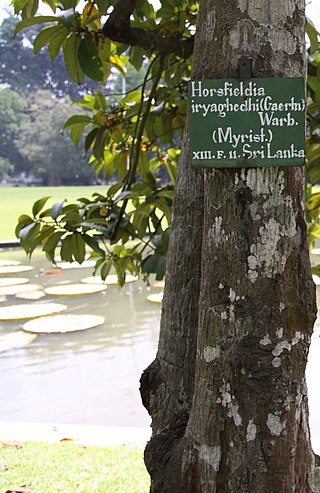
Manilkara bidentata is a species of Manilkara native to a large area of northern South America, Central America and the Caribbean. Common names include bulletwood, balatá, ausubo, massaranduba, quinilla, and (ambiguously) "cow-tree".

Magnolia tripetala, commonly called umbrella magnolia or simply umbrella-tree, is a deciduous tree native to the eastern United States in the Appalachian Mountains, the Ozarks, and the Ouachita Mountains. The name "umbrella tree" derives from the fact that the large leaves are clustered at the tips of the branches forming an umbrella-shaped structure.

Manilkara is a genus of trees in the family Sapotaceae. They are widespread in tropical and semitropical locations, in Africa, Madagascar, Asia, Australia, and Latin America, as well as various islands in the Pacific and in the Caribbean. A close relative is the genus Pouteria.

Juniperus procera is a coniferous tree native to mountainous areas in Africa and the Arabian Peninsula. It is a characteristic tree of the Afromontane flora.

Balaka seemannii is a species of flowering plant in the family Arecaceae that is endemic to Fiji; growing in mixed forests on Vanua Levu and Taveuni islands.
Acer duplicatoserratum is a species of maple, native to southern and eastern mainland China and Taiwan.
Boswellia nana is a species of plant in the Burseraceae family endemic to the Yemeni island of Socotra. They are small trees or shrubs, sometimes so bent that they are lying nearly horizontal to the ground.

Horsfieldia iryaghedhi is a species of plant in the family Myristicaceae. It is endemic to Sri Lanka.
Manilkara elata, also called the cow tree, is a species of plant in the family Sapotaceae. It is Endemic to the Amazon region in Brazil, where it is endangered by habitat loss.
Manilkara excelsa is a species of plant in the family Sapotaceae. It is endemic to Brazil, and threatened by habitat loss.
Manilkara excisa is an endangered species of tall tree in the sapodilla family. It is endemic to the extremely steep, forested limestone hills of Trelawny, Cockpit Country and St. James parishes in Jamaica, where, although it is highly prized for its wood, it is threatened by habitat loss.

Manilkara longifolia, commonly known as masseranduba, is a species of plant in the family Sapotaceae. It is endemic to Brazil, where it is threatened by habitat loss.
Manilkara paraensis is a species of plant in the family Sapotaceae. It is endemic to Brazil, where it is threatened by habitat loss.
Manilkara pleeana, the zapote de costa, is a species of plant in the family Sapotaceae. It is endemic to Puerto Rico.
Manilkara rufula is a species of tree in the Sapodilla family. It is endemic to the northeastern submontane forests of Bahia, Sergipe, Pernambuco, Paraíba, Ceará and Piauí states of Brazil. Although this species exists in many places, where it occurs it is either not numerous, or its numbers are declining due to loss of habitat.
Manilkara spectabilis is an uncommon species of tree in the sapodilla family.
Manilkara valenzuelana is a species of tree or tall shrub in the Sapodilla family. It is found in coastal and subcoastal semi-deciduous forests of Cuba, the Dominican Republic, Haiti, and possibly Puerto Rico. Its habitat has been declining rapidly under pressure from charcoal makers, logging, and the clearing of forest for human habitation.
Myristica atrescens is a species of plant in the family Myristicaceae. It is endemic to Papua New Guinea.
Sauropus assimilis is an extremely rare species of plant in the family Phyllanthaceae. It is a tree growing in wet evergreen forests in lowlands. Endemic to southwestern Sri Lanka, and only known from the Sinharaja Biosphere Reserve there, evidence of its existence was last catalogued before 1991, and it has not been found since then. It may since have become extinct.
Aiouea parvissima is a plant species in the family Lauraceae. It is endemic to Guatemala where it has only been found in the departments of Petén and Izabal. It is a tree or shrub of up to 7 m that grows in secondary broadleaf forest in association with Manilkara species.







